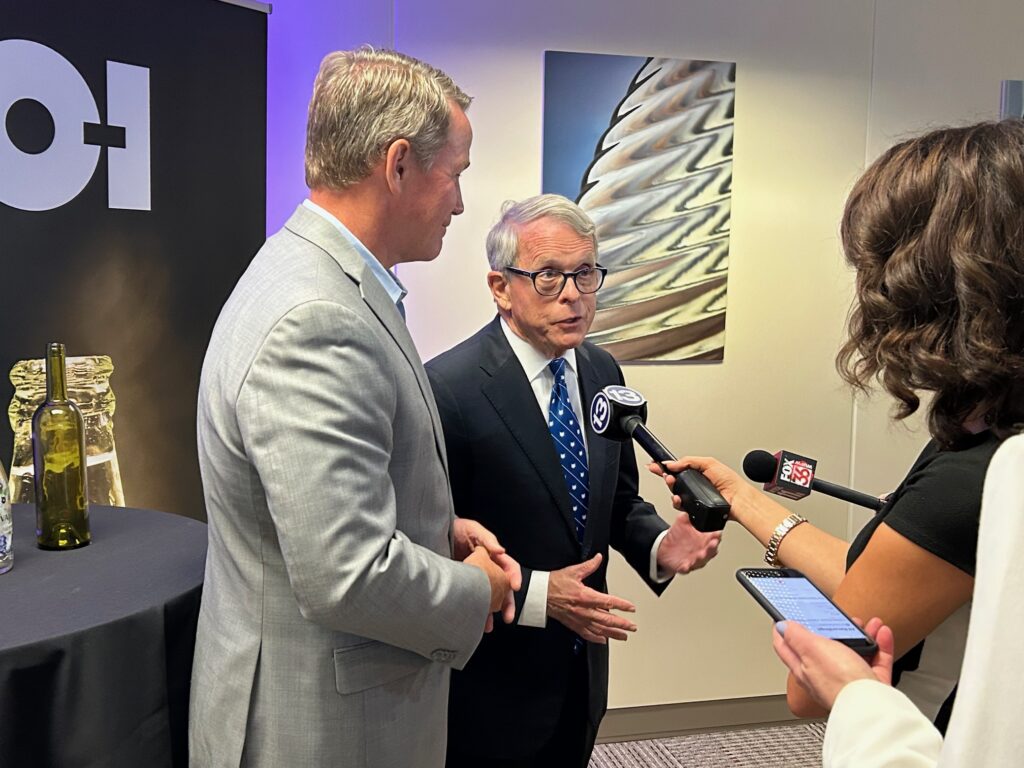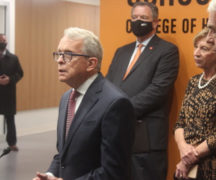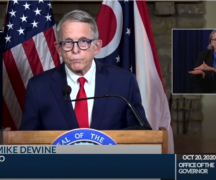By DAVID DUPONT
BG Independent News
Building on the northwest Ohio’s long history as a center of glass making, the state is investing in an initiative to make sure that industry continues to play an important part in the region’s future.
Gov. Mike DeWine visited Owens-Illinois headquarters in Perrysburg this morning (7/1/24) to announce that the state’s first innovation hub will focus on glass. Northwest Ohio Glass Innovation Hub will be located on the Owens Illinois campus just west of Levis commons it will have lab and research facilities.

That’s a perfect location for the $41.7 million project, said BGSU president Rodney Rogers. It’s equidistant between the campus of the University of Toledo and BGSU, the leading academic partners in the hub.
DeWine was joined by Lt. Gov. Jon Husted and Ohio Department of Development Director Lydia Mihalik. The state is providing $31.3 million for the hub.
That collaboration “will build on Toledo’s legacy as the Glass Capital of the World, and we believe will propel this region into the forefront of glass and solar innovation worldwide,” DeWine said.
The initiative, the first of several planned for the state, brings together industry, higher education, and workforce development efforts to promote innovation and tackle the challenges facing the glass industry.
DeWine noted that First Solar, Libbey Glass, Owens-Corning, and Pilkington North America are all involved in the glass sector, yet they do not compete. Each occupies a distinct niche in the market. The glass from the region is used for solar, automotive, and packaging industries.
The mission is to research and develop new technology to solve the most pressing issues in the glass and solar industries. That includes cost of materials, the need for an educated workforce, particularly people with doctorates, and ways to manufacture glass in sustainable ways.

“I am confident,” Husted said, “that this innovation collaborative will lead to glass products that are stronger, that are lighter, and that are more adaptable and that will use less energy to manufacture. That will give all of these companies in this region a competitive advantage in a globally competitive industry.”
Rogers noted that UT and BGSU already are bringing established programs to the table.
Toledo houses the Wright Center for Photovoltaics Innovation and Commercialization. BGSU boasts the Center for Photochemical Sciences and researchers in physics and chemistry who specialize in a wide range of coatings for glass. “We have an emerging number of faculty working on coating and films,” Rogers said. “Virtually all glass has some kind of coating.”
He said that 18 months ago when the initiative was just taking shape, he learned that a faculty member Mikhail Zamkov already had a contract with an area firm to create coatings for their products. This initiative “fits incredibly well” with the direction BGSU is already moving, Rogers said.
The funding includes money to bolster the faculty at both UT and BGSU. UT Interim President Matt Schroeder said that his institution is already conducting searches for two new positions.
Because BGSU is experiencing enrollment growth, Rogers said, it is in a position to add faculty. The university can focus on key areas in chemistry and physics and other STEM fields related to glass research. BGSU will also look to bring in more students, undergraduate, master’s, and doctoral students as well as some postdoctoral students interested in this field.
BGSU also brings expertise in supply chain management and advanced manufacturing to the table.
All this fits in with the direction BGSU is heading as it builds programs that train students for in-demand jobs. “Higher ed must strive to be more relevant and more consequential,” he said in his remarks.
Both universities will have space within the hub located at O-I, as well as continuing their work on their own campuses.
DeWine said a key part of the initiative is giving students the opportunity to work in the glass industry.
DeWine said there has been “historically a wall between the academic side and the business side. … We’re breaking it down.”
Husted said that the level of cooperation between higher education and industry in Northwest Ohio is what led to the glass hub being the first to be announced. Speaking of the Northwest Ohio Innovation Consortium, the lieutenant governor said: “They pulled this together very quickly. You usually don’t see this. They were the best organized.”
The consortium estimates that the project will have a $284 million economic impact on the northwest Ohio region, spurring $25 million in increased tax revenue and creating 1,600 new jobs over the next seven years. It also anticipates that targeted glass and solar education opportunities will bring in an estimated 230 new STEM graduates during the same period.
“This is important and impactful work,” Rogers said. The region’s glass industry is already world class. This will propel it to the next level.





